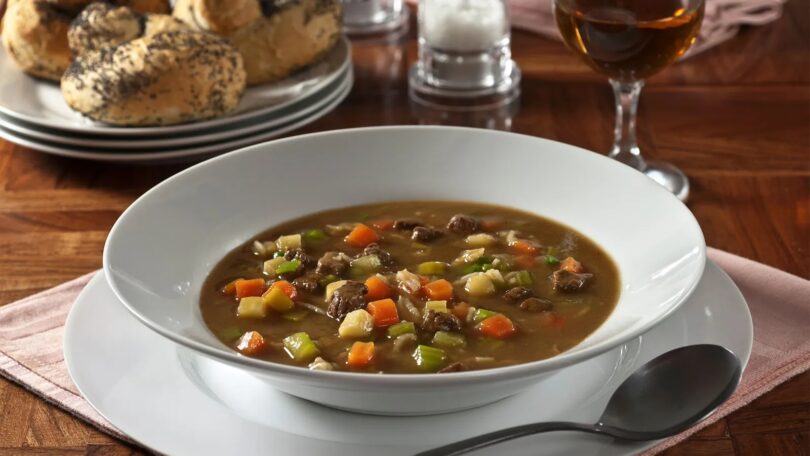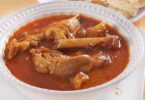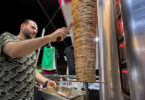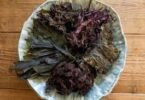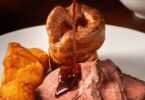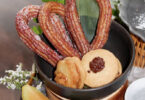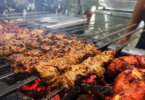Gary Jones
With the exception of the recently announced “Coronation Quiche”, the menu for King Charles III’s big-day banquet has yet to be made public, but the smart money says it will not kick off with a steaming bowl of Brown Windsor Soup.
Cookbooks and TV shows, celebrity chefs and high-table gastronomes say that Brown Windsor Soup – a hearty, meat-based broth, often with added root vegetables, that has long held a peculiar role in the national psyche – was the appetiser of choice for British kings and queens, princes and princesses for a couple of centuries.
One popular recipe-driven website describes the concoction as “the very soup reputed to have built the British Empire and one that was oh-so-fashionable in Victorian and Edwardian times”, adding: “Queen Victoria was particularly fond of it, and it regularly appeared on state banquet menus.”
A history blog, meanwhile, claims that in 1918, during World War One, the British royal family dumped their name of Saxe-Coburg-Gotha for that of the dun-hued dish – rather than for the Thames-side town that is home to the 11th-Century royal residence of Windsor Castle – in a bid to fend off anti-German sentiment.
With the forelock-tugging masses taking their cue from the royals, comforting Brown Windsor Soup had by then become the go-to British soup for the common people, and it wore that crown until at least the 1940s, and possibly into the ’80s, ladled out lavishly in loving homes and seaside hotels, and invariably featuring on the menu in richly upholstered British Railways dining cars. Or so the story goes.
But then, as with all culinary trends, the once-voguish dish fell out of favour. In the make-do years of rationing after World War Two, as its recipe degenerated with the scarcity of quality ingredients, Brown Windsor Soup came to be seen as an unappetising slop of puréed leftovers and cheap gravy granules – and only fit for seen-better-days boarding houses and penny-pinching minor schools.
It’s a colourful riches-to-rags tale, but even minimal research reveals it is likely a tall one, with experts in British culinary history arguing that the origin story of BWS is … well, almost certainly BS.
According to the late food historian Glyn Hughes, founder of the Foods of England Project that was established to find “the story behind every single traditional dish”, Brown Windsor Soup as the entrée choice of the blue-blooded was always a myth.
In his book The Lost Foods of England (2017), Hughes argued that Brown Windsor Soup has no aristocratic pedigree at all, and in the era of Queen Victoria – the soup’s alleged and opulent heyday, when its beefy essence was said to be fortified with Madeira wine from Portugal and other gastronomic exotica (such as quality cuts of steak and Andalucian sherry) – it likely never existed at all.
Hughes pointed out that Brown Windsor Soup was not included in any of the celebrated Victorian cookbooks – notably Eliza Acton’s Modern Cookery for Private Families (1845) and Isabella Beeton’s Mrs Beeton’s Book of Household Management (1861) – nor in any fiction or encyclopaedia of the time. In his research he found no 19th-Century restaurant menus featuring the dish and zero record of it in British Railways archives.
“Nothing, absolutely nothing, has caused more controversy around the Foods of England Project than the origins of Brown Windsor Soup.”
“Nothing, absolutely nothing, has caused more controversy around the Foods of England Project than the origins of Brown Windsor Soup,” wrote Hughes, who believed the colourful myth of Brown Windsor Soup had swallowed up the more drab – but quirkier – reality.
Hughes did find Brown Windsor Soup included on the menu of a cafe in a northern England department store in the 1920s, and cans of a dark “Windsor Soup” were commercially on sale in the 1940s, but he argued in his book that Brown Windsor Soup was not a dish steeped in history, but a creation of more modern popular culture.
Brown Windsor Soup only claimed its place in British culinary consciousness thanks to references in movies and shows – usually comedy shows – on radio and TV, quickly becoming a convenient punchline to jokes about lacklustre English gastronomy and the pretentious, class-conscious affectations of those for whom “Windsor” suggested elegance and refinement.
“Foods of England therefore officially concludes that Brown Windsor Soup was invented around about 1950 for comedic, not culinary, purposes,” Hughes wrote, “and all other histories of it are complete fantasy.”
There can be no doubt that variations of Brown Windsor Soup exist today, with a recipe in tongue-in-cheek bestseller The Unofficial Harry Potter Cookbook (“Brown Windsor Soup has a bad reputation, which it deserves… It’s hardly fit for human consumption”) and a more “regal” version using sirloin steak and Madeira in The Unofficial Downton Abbey Cookbook.
There is also a spin on the dish on Jamie Oliver’s website that employs “meltingly tender beef”, pearl barley, Worcestershire sauce and Marmite (“Tuck into this hearty and thick beef soup for a proper winter warmer”). And Michelin-starred chef Tom Kerridge included his Brown Windsor Soup in a celebratory menu created for the late Queen’s 90th birthday in 2016.
British writer Lindsey Bareham, meanwhile, believes Brown Windsor Soup was “a forebear of the ubiquitous ‘brown soup’ that was… largely responsible for giving British soups a bad name” and the dish is “almost extinct now”. She argues, however, that “made properly it is rich and sustaining, rather like liquid stew”, and she includes the recipe for a “good one” in her popular book A Celebration of Soup.
So, what really came first: the myth or the soup? And how did the monarchy get dragged into the mix?
If there is one place where it would surely appear on posh restaurant and traditional pub menus, that would be Windsor itself, which is one of England’s most touristed spots. But a mini walking tour of the many culinary choices surrounding the massive, grey-stone castle proves fruitless.
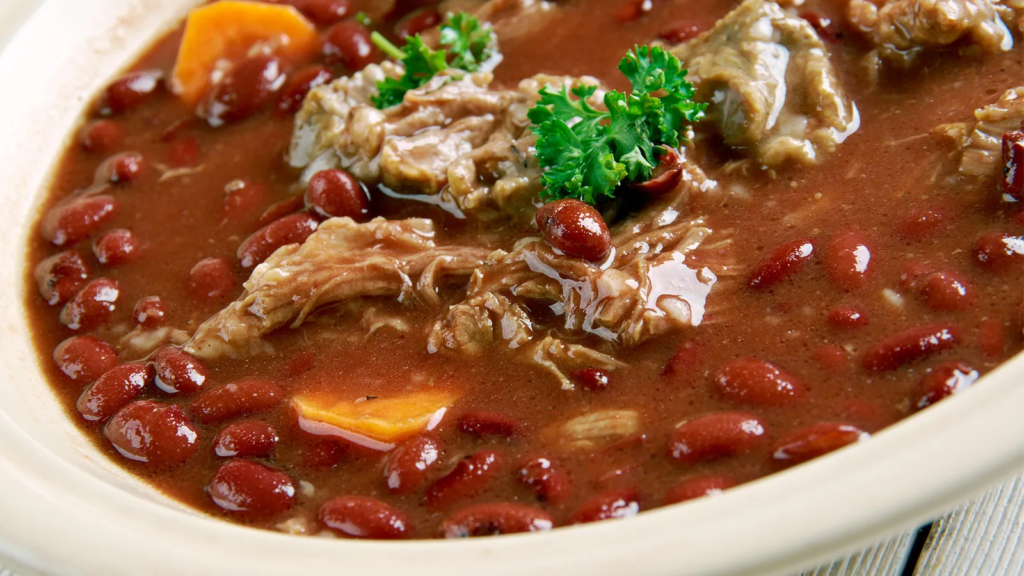
The menu at The Royal Windsor pub, which nestles in the shadow of the castle’s imposing keep, includes no soups at all, but contemporary appetisers such as glazed chicken skewers, crispy coated whitebait and vegetable gyoza. The set menu at designer-chic venue The Ivy Royal Windsor Brasserie, which is located opposite the town’s landmark statue of Victoria and the castle’s Henry VIII Gateway entrance, has the option to begin with a creamed cauliflower soup; while the more affordable King & Castle beside the curfew tower makes do with nachos, wings and assorted pub-grub nibbles.
“Brown Windsor soup has nothing to do with royalty at all,” said Marc Meltonville, a food historian who has acted as a consultant to the UK’s Historic Royal Palaces charity that manages a number of the UK’s unoccupied royal residences, including Hampton Court Palace just a few miles downriver. “There were a couple of ‘Windsor’ soups in the 19th Century, and there were also brown soups… The brown soups of the Victorians were really good beef broths.
The soups using “Windsor” in their names were white soups, however, with the first being a creation of Henderson William Brand, chef to King George IV, who preceded Victoria on the throne, and the inventor of what would become A1 Sauce. In 1834, Brand published a cookbook containing a recipe for “Vermicelli Soup, a la Windsor” that employed white meat and noodles.
Eleven years later, in his influential tome The Modern Cook, British-Italian Charles Elmé Francatelli, who was Victoria’s head chef from 1840 to 1842, cooked up “Calf’s Feet Soup, a la Windsor”, its pale hue resulting from the ample addition of cream, chicken, white wine and macaroni.
Then, Meltonville continues, in the 20th Century, the two descriptors – Windsor and brown – were inexplicably “welded together” to create the name of a soup that had previously not existed. The result proved less palatable than either.
So where did the name Brown Windsor soup come from? One school of thought has it that the confusion derived from “Brown Windsor Soap”, a luxury personal hygiene product that was popular in 19th-Century high society, with Victoria said to be a fan (and Napoleon before her, and Winston Churchill sometime after).
Surrealist comic Spike Milligan was one of the first to see the comedy potential of Brown Windsor Soup, it seems, with it used more than once as the butt of jokes in The Goon Show – a BBC radio programme much loved, coincidentally, by the young Prince Charles in the 1950s. Countless others have run with the gag since then, with Brown Windsor Soup taking a walk-on role in everything from Hancock’s Half Hour and multiple Carry On films to television’s Rumpole of the Bailey and the 2021 BBC series Around the World in 80 Days, among others.
Having been so totally embraced by British popular culture for decades, Hughes argued that a form of “mass hallucination” had come to pass, with many people’s personal memories of the soup being false. And yet a huge number of British folk insist they remember the soup, frequently with shivers of dread but also occasionally with nostalgic affection.
Writing in the Mail on Sunday newspaper in 2010, columnist Peter Hitchens recalled being offered a meal on a train between York and London “sometime in the late 1970s”. It was shortly after 09:00 and the proffered meal started “with Brown Windsor Soup, continuing with roast lamb and ending with cheese and biscuits,” Hitchens wrote. “When I jokingly said that this was a pretty odd breakfast, an angry steward… ordered me out of the dining car.”
And writing in The Spectator magazine just last year under the headline “Make rail travel great again”, Hitchens suggested that Eurostar should include “a proper dining car” on its trains, where passengers might “subside into deep seats” to be “served Brown Windsor Soup followed by delicious railway fish and then perhaps apple pie”.
The Brown Windsor Soup association with train travel runs deep in the British psyche, despite the fact that Hughes found no record of it in British Railways archives, with soups rarely served on bouncing, lurching trains for obvious reasons.
In the 1994 TV adaptation of Agatha Christie’s novel Hercule Poirot’s Christmas, the fussy Belgian detective is on a train journey and he is hungry. Of the attendant in the dining car he asks, “Please tell me, what is this Brown Windsor Soup?” To which he is told, “Well sir, it is soup. From Windsor.” On being served his requested dish, Poirot is shocked. “But it does not look very délicieux,” he said with disappointment. “Well, it is Brown Windsor Soup,” comes the passionless reply. (It should be noted that no such scene appears in Christie’s original 1938 novel.)
“The ‘Windsor’ thing is a bit of a joke, really – a nuisance.”
“The ‘Windsor’ thing is a bit of a joke, really – a nuisance,” Meltonville said of the label. “A chef can take a recipe that already exists, add one new ingredient and then put a spin on it by adding ‘Windsor’ or ‘coronation’ to its name – or ‘Buckingham’, suggesting it was made in Buckingham Palace.”
And looking ahead to King Charles’ coronation, the historian adds: “I’ll be interested to see what dish is given ‘à la royale’. There will be something à la royale, I’m sure of it.”
According to a menu found online and purporting to be from Queen Victoria’s coronation banquet in 1838, that extravagant meal began with green turtle soup, and though she presided over numerous banquets throughout her reign of almost 64 years, Brown Windsor Soup does not seem to appear on surviving menus. Rice soup, threaded egg soup, pheasant dumpling soup, a chicken consommé thickened with tapioca… many other soups graced Victoria’s table though the years, but Brown Windsor Soup never made the grade. It was not even served at the luncheon for her Windsor funeral on 2 February 1901. That honour went to consommé à la doria – a game soup topped with white truffles from Piedmont.
All the evidence, in fact, suggests that while food might be an integral part of royal and state events, monarchs of recent centuries have not been especially fussy about the fodder served up to them, even for their once-in-a-regal-lifetime coronation feasts, with Victoria appearing especially indifferent.
“Queen Victoria cared so little about her coronation banquet,” Meltonville said, “that in her diary she wrote all about the actual coronation, the things that went wrong, who fell over – including one bishop – what everyone wore, and then at the end she simply writes, ‘And we dined at eight.'”
Courtesy: BBC

